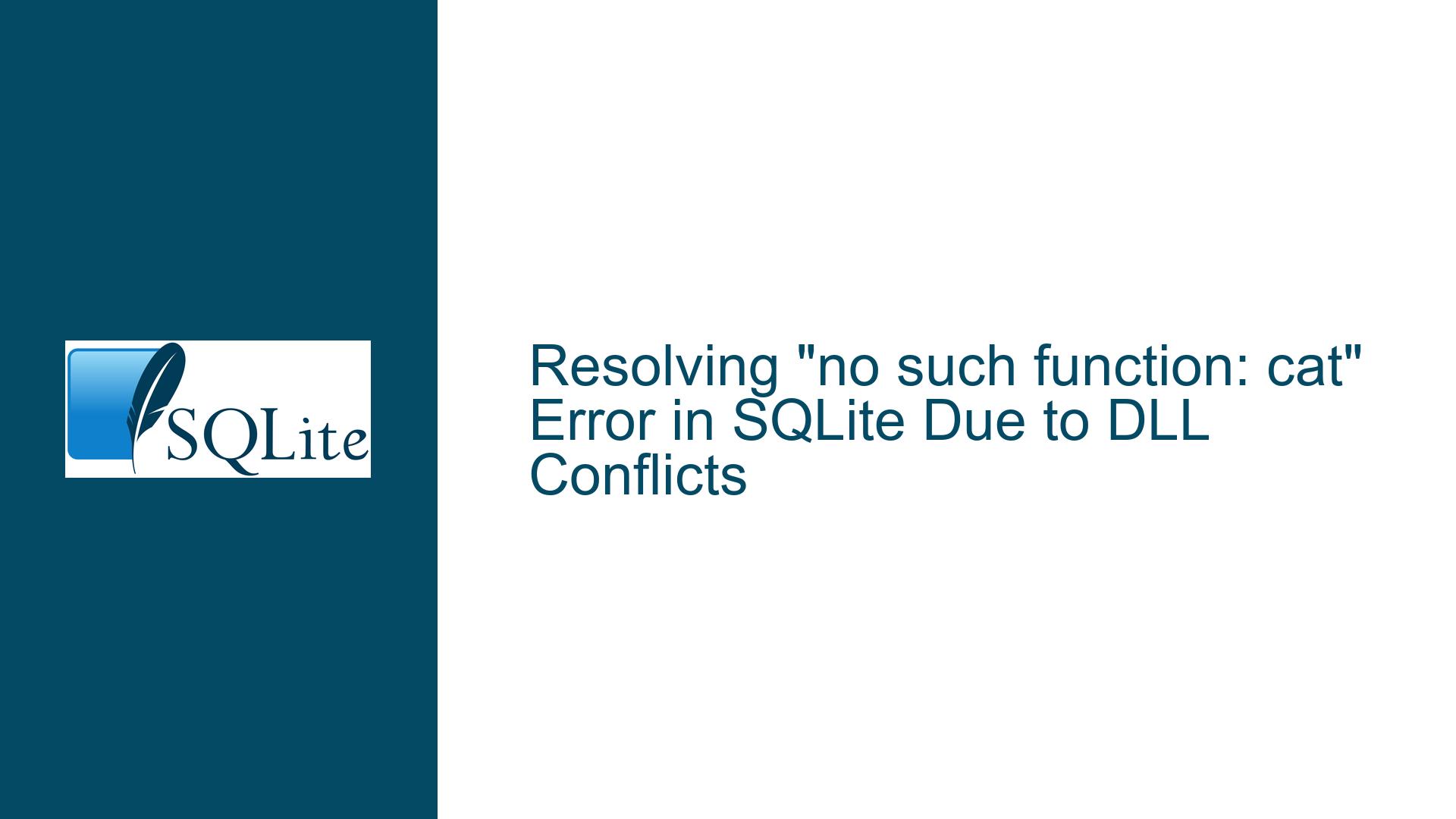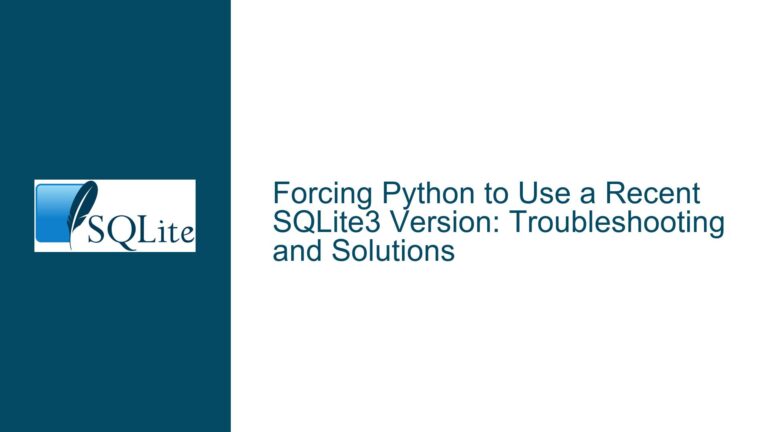Resolving “no such function: cat” Error in SQLite Due to DLL Conflicts
Understanding the "no such function: cat" Error in SQLite
The error message "no such function: cat" in SQLite indicates that the database engine is unable to recognize the function cat as a valid SQL function. This error typically arises when a user attempts to execute a query that includes a function call that SQLite does not natively support or recognize. In this specific case, the user intended to use the concat function but mistakenly typed cat. While the immediate issue was a typo, the deeper investigation revealed a more complex underlying problem related to the SQLite dynamic link library (DLL) configuration on the user’s system.
SQLite is a lightweight, serverless database engine that is widely used due to its simplicity and efficiency. However, its functionality can be extended through the use of custom functions, which are often implemented in external libraries. These libraries are typically loaded into SQLite as DLLs on Windows systems. The error in question highlights a scenario where the SQLite environment is not correctly configured to recognize or load the necessary functions, leading to the "no such function" error.
The user initially believed that the cat function was valid because they had successfully executed similar queries in the past. This discrepancy suggests that the environment in which the query was previously executed had a different configuration or additional extensions loaded that provided the cat function. The resolution of this issue involved identifying and rectifying the configuration differences between the two systems in use.
Investigating the Root Causes of Function Recognition Failures
The primary cause of the "no such function: cat" error is the absence of the cat function in SQLite’s built-in function library. SQLite natively supports a variety of scalar functions, such as concat, substr, and length, but it does not include a function named cat. When a user attempts to call a non-existent function, SQLite raises an error indicating that the function is not recognized.
However, the user’s experience of having successfully executed the query in the past suggests that the cat function was available in a previous environment. This could be due to several reasons:
Custom Function Extensions: The user might have previously used an environment where a custom extension providing the
catfunction was loaded. SQLite allows users to define their own functions using the C API, and these functions can be compiled into a DLL and loaded at runtime. If such an extension was present in the past but is missing in the current environment, the function would no longer be available.Configuration Differences: The user mentioned using two different systems, with the query working on one but not the other. This indicates that the systems have different SQLite configurations. One system might have additional extensions or a different version of SQLite that includes the
catfunction, while the other does not.DLL Conflicts: The user discovered that multiple applications on their system were shipping their own versions of the
sqlite3.dllfile. This can lead to conflicts where the wrong version of the DLL is loaded, resulting in missing or unrecognized functions. In this case, the version ofsqlite3.dllshipped with SqliteStudio was causing the issue, as it did not include thecatfunction.Typographical Errors: The immediate cause of the error was a typo—using
catinstead ofconcat. While this is a simple mistake, it highlights the importance of careful query construction and the need for thorough error checking.
Resolving DLL Conflicts and Ensuring Proper Function Recognition
To resolve the "no such function: cat" error and prevent similar issues in the future, the following steps can be taken:
Verify Function Names: Always double-check the function names in your SQL queries. SQLite provides a comprehensive list of built-in functions in its documentation. If you are using a custom function, ensure that it is correctly named and available in your environment.
Check for Custom Extensions: If you rely on custom functions, verify that the necessary extensions are loaded. In SQLite, custom functions can be loaded using the
load_extensionfunction. Ensure that the extension is correctly compiled and accessible from your SQLite environment.Resolve DLL Conflicts: When multiple applications ship their own versions of
sqlite3.dll, conflicts can arise. To resolve this, identify which version of the DLL is being used by your SQLite environment. You can do this by checking thePATHenvironment variable and ensuring that the correct version ofsqlite3.dllis prioritized. In the user’s case, renaming the version ofsqlite3.dllshipped with SqliteStudio forced the system to use the version in thePATH, resolving the issue.Standardize SQLite Installations: To avoid configuration differences between systems, standardize the SQLite installation across all environments. Use the same version of SQLite and ensure that all necessary extensions are consistently available. This can be achieved by maintaining a centralized repository of SQLite binaries and extensions.
Use SQLite Management Tools: Tools like SqliteStudio can simplify database management but can also introduce configuration complexities. Ensure that these tools are correctly configured to use the desired version of SQLite. If necessary, adjust the tool’s settings to point to the correct
sqlite3.dllfile.Test Queries Across Environments: If you work with multiple systems, test your queries across all environments to identify any discrepancies. This can help you catch issues related to missing functions or configuration differences early in the development process.
Consult Documentation and Community: SQLite has extensive documentation and an active community. If you encounter an error, consult the documentation to understand the supported functions and their usage. Additionally, seek advice from the community, as other users may have encountered and resolved similar issues.
By following these steps, you can ensure that your SQLite environment is correctly configured and that your queries execute as expected. The "no such function: cat" error serves as a reminder of the importance of careful configuration management and the need to verify function availability across different environments.
In conclusion, the "no such function: cat" error in SQLite is a multifaceted issue that can arise from typographical errors, missing custom extensions, configuration differences, and DLL conflicts. By understanding the root causes and implementing the recommended troubleshooting steps, you can resolve this error and maintain a robust SQLite environment. Whether you are a seasoned database developer or a newcomer to SQLite, these insights will help you navigate the complexities of function recognition and ensure the smooth execution of your queries.






